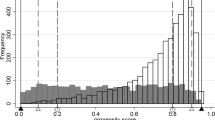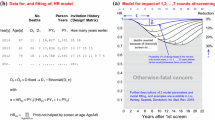Abstract
In situations where randomized trials are not feasible, analysis of observational data must be used instead. However, when using observational data, there is often selection bias for which we must account in order to adjust for pre-treatment differences between groups in their baseline characteristics. As an example of this, we used the Linked Medicare-Tumor Registry Database created by the National Cancer Institute and the Centers for Medicare and Medicaid Services to look at screening with mammography in older women to determine its effectiveness in detecting cancer at an earlier stage. The standard regression method and two methods of adjusting for selection bias are compared. We start with the standard analysis, a logistic regression predicting stage at diagnosis that includes as independent variables a set of covariates to adjust for differences in baseline risk plus an indicator variable for whether the woman used screening. Next, we employ propensity score matching, which evens out the distribution of measured baseline characteristics across groups, and is more robust to model mis-specification than the standard analysis. Lastly, we conduct an instrumental variable analysis, which addresses unmeasured differences between the users and non-users. This article compares these methods and discusses issues of which researchers and analysts should be aware. It is important to look beyond the standard analysis and to consider propensity score matching when there is concern about group differences in measured covariates and instrumental variable analysis when there is concern about differences in unmeasured covariates.
Similar content being viewed by others
References
I. Andersson, K. Aspgren and L. Janzon, et al., “Mammographic screening and mortality from breast cancer: the malmo mammographic screening trial,” BMJ, 297, pp. 943-948, 1998. 288 POSNER ET AL.
J. D. Angrist, G. W. Imbens and D. B. Rubin, “Identification of causal effects using instrumental variables,” JASA, 96, pp. 444-472, 1996.
O. H. Beahers and M. H. Myers, Manual for Staging of Cancer, 2nd ed. JB Lipincott, Philadelphia, 1983.
J. Bound, D. A. Jaeger and R. M. Baker, “Problems with instrumental variables estimation when the correction between the instruments and the endogenous explanatory variable is weak,” JASA, 90, pp. 443-450, 1995.
R. B. Burns, McCarthy and K. M. Freund, et al., “Variability in mammography use among older women,” JAGS, 44, pp. 922-926, 1996.
W. G. Cochran, “The effectiveness of adjustment by subclassification in removing bias in observational studies,” Biometrics, 24, pp. 205-213, 1968.
R. A. Deyo, D. C. Cherkin and M. A. Ciol, “Adapting a clinical comoridity index for use with IDC-9-CM Administrative database,” J Clin Epidemiol, 45, pp. 613-619, 1992.
C. Drake, “Effects of misspecification of the propensity score on estimators of treatment effect,” Biometrics, 49, pp. 1231-1236, 1993.
W. H. Greene, Econometric Analysis, Prentice Hall, New Jersey, 288-295, 1997.
S. Greenland, “An introduction to instrumental variables for epidemiologists,” Int J Epidemiol, 29, pp. 722-729, 2000.
M. M. Joffe and P. R. Rosenbaum, “Invited commentary: propensity scores,” Am J Epidemiol, 150, pp. 327-333, 1999.
E. P. McCarthy, R. B. Burns, K. M. Freund, A. S. Ash, M. Shwartz, S. L. Marwill and M. A. Moskowitz, “Mammography use, breast cancer stage at diagnosis, and survival among older women,” J Am Geriatr Soc, 48, pp. 1226-1233, 2000.
E. P. McCarthy, R. B. Burns, S. S. Couglin, K. M. Freund, J. Rick, S. L. Marwill, A. Ash, M. Shwartz and M. A. Moskowitz, “Mammography use helps to explain differences in breast cancer stage at diagnosis between older black and white women,” Ann Intern Med, 128, pp. 729-736, 1998.
K. M. Murphy, R. H. Topel, “Estimation and inference in two-step econometic models,” Journal of Business and Economic Statistics, 3(4), pp. 370-379, 1985.
A. B. Nattinger, M. S. Gottlieb, J. Veum, D. L. Yagnke and J. S. Goodwin, “Goegraphic variation in the use of brest conserving treatment for breast cancer,” N EngI J Med, 326, pp. 1102-1107, 1992.
A. B. Nattinger, M. S. Gottlieb, R. G. Hoffman, A. P. Walker and J. S. Goodwin, “Minimal increase in use of breast-conserving surgery from 1986 to 1990,” Med Care, 24, pp. 479-489, 1996.
J. P. Newhouse and M. McClellan, “Econometrics in outcomes research: the use of instrumental variables,” Ann Rev Public Health, 19, pp. 17-34, 1998.
A. L. Potosky, G. F. Riley, J. D. Lubitz, R. M. Mentnech and L. G. Kessler, “Potential for cancer realted health services research using a linked medicare-tumor registry database,” Med Care, 31, pp. 732-748, 1993.
L. A. G. Ries, C. L. Kosary and B. F. Hankey, et al., SEER Cancer Statistics Review, 1973-1994. National Cancer Institute, Bethesda, MD, 1997. NIH Publication, 97-2789.
M. Roberts, F. E. Alexander and T. J. Anderson, et al., “Edinburgh trial of screening for breast cancer mortality of seven years,” Lancet, 335, pp. 241-246, 1990.
J. M. Robins, “The analysis of randomized and non-randomized AIDS treatment trials using a new approach to causal inference in longitudinal studies,” in Health Service Research Methodology: A Focus on AIDS (L. Sechrest, H. Freeman, and A. Mulley, eds.), US Public Health Service, Washington, DC, pp. 113-159, 1989.
P. R. Rosenbaum and D. B. Rubin, “The central role of the propensity score in observational studies for causal effects,” Biometrika, 70, pp. 41-55, 1983.
S. Shapiro, W. Venet, P. Strax, et al., “Ten to fourteen year effect of screening on breast cancer mortality,” J Natl Cancer Inst, 69, pp. 349-355, 1982.
L. B. Sheiner, D. B. Rubin, “Intention-to-treat analysis and the goals of clinical trials,” Clin Pharm Therap, 57, pp. 6-15, 1995.
D. Staiger and J. H. Stock, “Instrumental variables regression with weak instruments,” Econometrica, 63(3), pp. 557-586, 1997. COMPARING REGRESSION, PROPENSITY SCORES, AND IV 289
L. Tabar, A. Gad, L. H. Holmberg, et al., “Reduction in mortality from breast bancer after mass screening with mammography. Randomized trial from the breast cancer working group of Swedish national board of health and welfare,” Lancet, 1, pp. 829-832, 1985.
S. Wright, “Appendix,” in The Tariff on Animal and Vegetable Oils, (P. G. Wright, ed.), Macmillan, New York, 1928.
Health Services Research, Vol 35, No. 5. Part II. December 2000.
Author information
Authors and Affiliations
Rights and permissions
About this article
Cite this article
Posner, M.A., Ash, A.S., Freund, K.M. et al. Comparing Standard Regression, Propensity Score Matching, and Instrumental Variables Methods for Determining the Influence of Mammography on Stage of Diagnosis. Health Services & Outcomes Research Methodology 2, 279–290 (2001). https://doi.org/10.1023/A:1020323429121
Issue Date:
DOI: https://doi.org/10.1023/A:1020323429121




